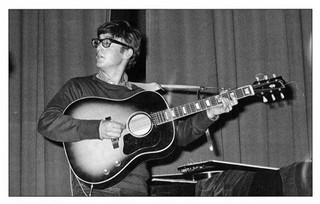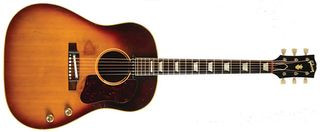The world of music history witnessed a landmark event when John Lennon’s long-lost Gibson J-160E acoustic-electric guitar fetched a record-breaking $2.41 million at a Julien’s auction. This iconic instrument, intimately linked to the genesis of Beatlemania, had been missing for over four decades, adding an aura of mystery and intrigue to its already legendary status. Originally estimated at $800,000, the guitar surpassed expectations threefold, selling to an anonymous buyer who now possesses a tangible piece of music history.
This particular Gibson J-160E is one of two nearly identical models acquired by Beatles manager Brian Epstein for John Lennon and George Harrison on September 10, 1962. Purchased from Rushworth’s Music House in Liverpool for a mere £161.05 each – approximately $450 then, or $4,600 in today’s currency – these guitars became integral to the Beatles’ early sound. Lennon’s J-160E was not just any guitar; it was a songwriting companion, used to co-compose timeless classics with Paul McCartney such as “I Saw Her Standing There,” “She Loves You,” and the globally recognized anthem, “I Want to Hold Your Hand.” The Gibson J-160E, with its distinctive sound and playability, played a crucial role in shaping the melodies that defined a generation.
 John Lennon playing his Gibson J-160E guitar during the early years of The Beatles, highlighting the instrument's iconic presence in their formative period.
John Lennon playing his Gibson J-160E guitar during the early years of The Beatles, highlighting the instrument's iconic presence in their formative period.
The Mysteriously Vanished Gibson J-160E
The tale of the missing Gibson J-160E is as captivating as the music it helped create. After a Beatles’ concert in London at the Finsbury Park Astoria Theater in 1963, the guitar seemingly vanished. Legend has it that Mal Evans, the band’s roadie, inadvertently left it behind. Evans himself reportedly considered this incident “when I lost John’s guitar” as a career low point. Lennon’s playful ribbing of Evans, “Mal, you can have your job back as soon as you find my guitar,” only cemented the guitar’s mythical disappearance into Beatles lore.
For four years, the Gibson J-160E remained untraced, its whereabouts a complete enigma. Then, in 1967, it resurfaced at the Blue Guitar shop in San Diego, a local hub for folk, rock, and bluegrass musicians. Likely taken in as a trade-in, the details of its arrival remain shrouded in mystery – no one at the store recalls the transaction, and no records exist. Tommy Pressley, a young carpenter’s apprentice and bluegrass enthusiast, purchased the vintage Gibson J-160E for a modest $175, unaware of its monumental history.
Two years later, needing funds for a relocation, Pressley sold the guitar to his childhood friend, John McCaw, for the same price. McCaw, a contractor in San Diego, owned the instrument for over four decades, playing it sporadically, often keeping it as a decorative piece. “What you see today,” McCaw noted, referring to the guitar’s wear and tear, “is exactly the way it looked the day I bought it 46 years ago. All the little dents and nicks and dings that you see were all there.” Unbeknownst to McCaw, his vintage Gibson J-160E was a priceless artifact of music history.
Rediscovery and Authentication of a Legend
The remarkable rediscovery of Lennon’s Gibson J-160E began in April 2014. After a guitar lesson, McCaw noticed a copy of Guitar Aficionado magazine featuring Dhani Harrison, George Harrison’s son, on the cover. Inside, an article showcased George’s 1962 Gibson J160-E. Intrigued by the serial number similarity, McCaw and Marc Intravaia, his guitar lesson instructor and owner of Sanctuary Art and Music Studio, contacted Andy Babiuk, renowned author of Beatles Gear.
Babiuk, after careful examination, authenticated the instrument as the long-lost Lennon Gibson J-160E. This revelation was further solidified by the guitar’s inclusion on the cover of the revised edition of Babiuk’s book, Beatles Gear—The Ultimate Edition. The realization of owning such a significant piece of music history prompted McCaw to sell the guitar. “[I] realized I can’t keep the guitar,” McCaw explained. “It’s too big for me. It’s not going to fit in my house anymore.”
 Close-up of the Gibson J-160E acoustic-electric guitar, highlighting its sunburst spruce finish, P-90 single-coil pickups, and the wear marks accumulated over its fascinating journey.
Close-up of the Gibson J-160E acoustic-electric guitar, highlighting its sunburst spruce finish, P-90 single-coil pickups, and the wear marks accumulated over its fascinating journey.
The Gibson J-160E: An Icon of Rock History
The Gibson J-160E itself is a significant model in guitar history. Introduced in 1954, the J-160E was Gibson’s first attempt at a commercially successful acoustic-electric guitar. Its design, featuring a spruce top and mahogany back and sides, coupled with a single-coil pickup, produced a unique amplified acoustic tone that was embraced by artists across genres. The J-160E became particularly famous through its association with the Beatles, especially Lennon and Harrison, who used their nearly identical models extensively in their early recordings and performances.
Lennon’s Gibson J-160E holds a particularly special place in the Beatles’ discography. Its earliest documented use was during the pivotal Abbey Road recording sessions on September 11, 1962. On this day, with Ringo Starr newly installed as drummer, the Beatles recorded their debut hits, “Love Me Do” and “P.S. I Love You,” songs forever etched in music history, played on this very Gibson J-160E.
The sale of John Lennon’s Gibson J-160E for $2.41 million is not just a testament to the guitar’s historical value, but also to the enduring legacy of the Beatles and the Gibson J-160E’s crucial role in shaping their groundbreaking sound. For guitar enthusiasts and music historians alike, this instrument represents a tangible link to a transformative era in music, a time when the Gibson J-160E helped to soundtrack the burgeoning youth culture of the 1960s. A more in-depth exploration of this remarkable guitar’s journey was promised in the January 2016 issue of Guitar World, further underscoring the enduring fascination with John Lennon’s iconic Gibson J-160E.

